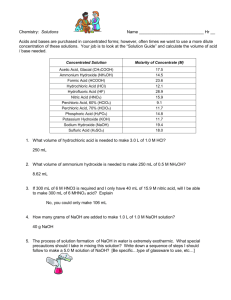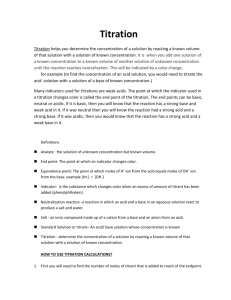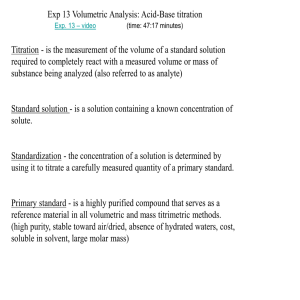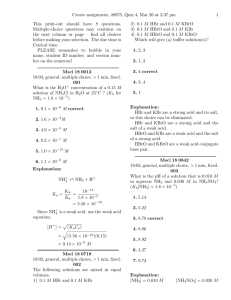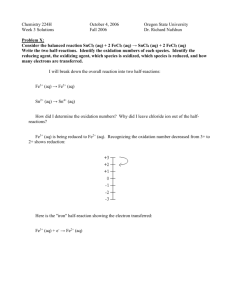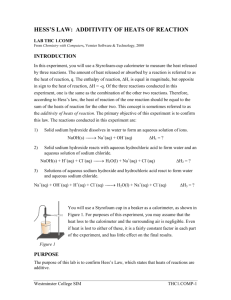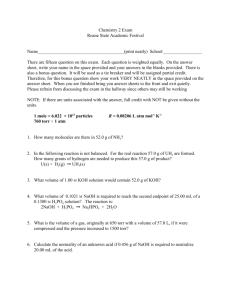Molarity, Dilution and pH
advertisement
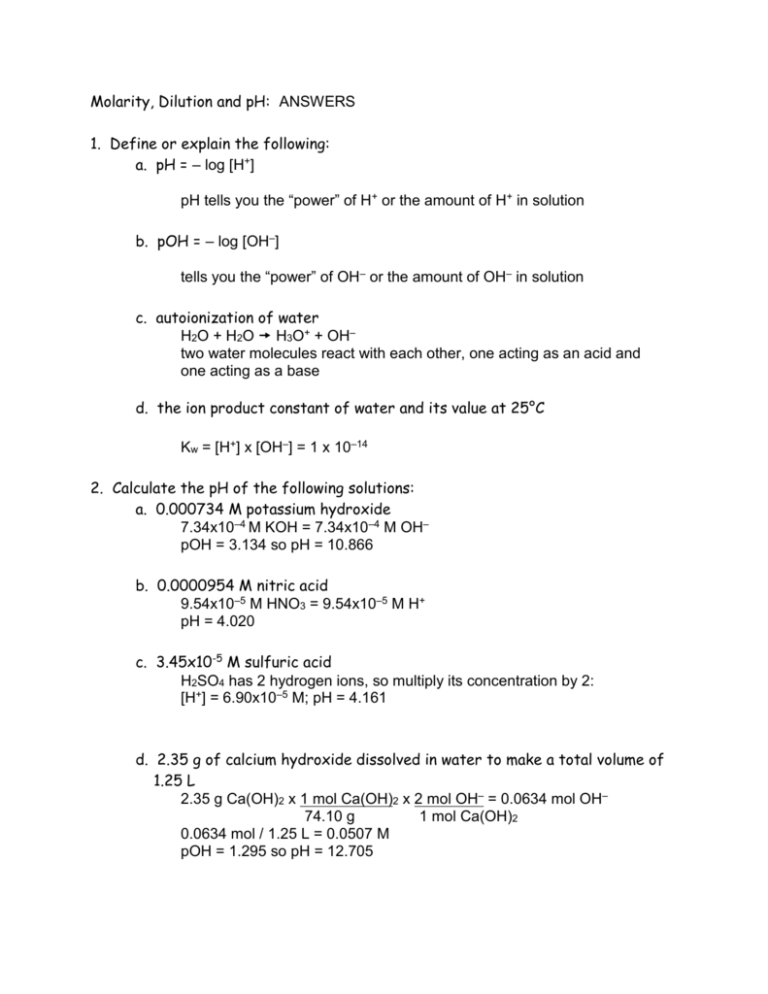
Molarity, Dilution and pH: ANSWERS 1. Define or explain the following: a. pH = – log [H+] pH tells you the “power” of H+ or the amount of H+ in solution b. pOH = – log [OH–] tells you the “power” of OH– or the amount of OH– in solution c. autoionization of water H2O + H2O H3O+ + OH– two water molecules react with each other, one acting as an acid and one acting as a base d. the ion product constant of water and its value at 25°C Kw = [H+] x [OH–] = 1 x 10–14 2. Calculate the pH of the following solutions: a. 0.000734 M potassium hydroxide 7.34x10–4 M KOH = 7.34x10–4 M OH– pOH = 3.134 so pH = 10.866 b. 0.0000954 M nitric acid 9.54x10–5 M HNO3 = 9.54x10–5 M H+ pH = 4.020 c. 3.45x10-5 M sulfuric acid H2SO4 has 2 hydrogen ions, so multiply its concentration by 2: [H+] = 6.90x10–5 M; pH = 4.161 d. 2.35 g of calcium hydroxide dissolved in water to make a total volume of 1.25 L 2.35 g Ca(OH)2 x 1 mol Ca(OH)2 x 2 mol OH– = 0.0634 mol OH– 74.10 g 1 mol Ca(OH)2 0.0634 mol / 1.25 L = 0.0507 M pOH = 1.295 so pH = 12.705 3. Concentrated hydrochloric acid is 12 M. 8.5 mL of this is diluted to a total volume of 250. mL. What is the pH of the final solution? (12 M)(8.5 mL) = M2 (250. mL) M2 = 0.41 M HCl so [H+] = 0.41 M pH = 0.39 a. What volume of the above solution would have to be diluted to 1.0 L to give a final pH of 5.43? 5.43 = –log [H+] so 10–5.43 = [H+] = 3.72x10–6 M (0.41 M)(V1) = (3.72x10–6 M)(1.0 L) V1 = 9.06x10–6 L 4. What is the difference between a weak acid and a dilute acid? A weak acid has very little dissociation into ions. A dilute acid can be strong or weak, but its concentration is low. 5. What is the difference between a strong acid and a concentrated acid? A strong acid dissociates 100% into ions. A concentrated acid has a high molarity, but can be strong or weak. 6. A lithium hydroxide solution has a pH of 10.87. What was the concentration of the solution? 10.87 = –log [H+] [H+] = 10–10.87 = 1.349x10–11 M [OH–] = 1 x 10–14 = 7.413 x 10–4 M = [LiOH] 1.349x10–11 7. How much solid NaOH would have to be dissolved in 5.0 L of water to give a pH of 11.35? pH = 11.35 so pOH = 2.65 [OH–] = 10–2.65 = 2.24x10–3 M 2.24x10–3 mol NaOH x 5.0 L x 40.00 g NaOH = 0.45 g NaOH 1L 1 mol NaOH 8. What is the pH if 25 mL of 0.00234 M HCl is mixed with 125 mL of 0.0000874 M NaOH? [H+] = (25 mL)(0.00234 M) = 3.9x10–4 M 150. mL [OH–] = (125 mL)(8.74x10–5 M) = 7.28x10–5 M → less OH– in soln, so calc. 150. mL the H+ remaining + –4 –5 –4 [H ] = 3.9x19 M – 7.28x10 M = 3.2x10 M pH = –log (3.2x10–4) = 3.5 9. 750. mL of hydrochloric acid solution has a pH of 1.35. Approximately how many grams of sodium hydroxide would have to be added to the solution to neutralize all of the acid? pH = 1.35 [H+] = 10–1.35 = 0.0447 M 0.0447 M HCl x 0.750 L = 0.00335 mol HCl → need same moles of NaOH 1L to neutralize the acid 0.00335 mol NaOH x 40.00 g NaOH = 0.134 g NaOH 1 mol NaOH 10. List all the strong acids you know. HCl, HBr, HI, HNO3, HClO4, H2SO4 11. List all the strong bases you know. LiOH, NaOH, KOH, RbOH, CsOH, FrOH Be(OH)2, Mg(OH)2, Ca(OH)2, Sr(OH)2, Ba(OH)2, Ra(OH)2


